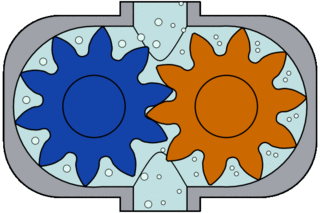This article needs additional citations for verification. Please help improve this articlebyadding citations to reliable sources. Unsourced material may be challenged and removed.
Find sources: "Gear pump" – news · newspapers · books · scholar · JSTOR (February 2010) (Learn how and when to remove this message) |
Agear pump uses the meshing of gearstopump fluid by displacement.[1] They are one of the most common types of pumps for hydraulic fluid power applications. The gear pump was invented around 1600 by Johannes Kepler.[2]




Gear pumps are also widely used in chemical installations to pump high-viscosity fluids. There are two main variations: external gear pumps which use two external spur gears, and internal gear pumps which use an external and an internal spur gear (internal spur gear teeth face inwards, see below). Gear pumps provide positive displacement (orfixed displacement), meaning they pump a constant amount of fluid for each revolution. Some gear pumps are designed to function as either a motor or a pump.
As the gears rotate they separate on the intake side of the pump, creating a void and suction which is filled by fluid. The fluid is carried by the gears to the discharge side of the pump, where the meshing of the gears displaces the fluid. The mechanical clearances are small— on the order of 10 μm. The tight clearances, along with the speed of rotation, effectively prevent the fluid from leaking backwards.
The rigid design of the gears and houses allow for very high pressures and the ability to pump highly viscous fluids.
Many variations exist, including helical and herringbone gear sets (instead of spur gears), lobe shaped rotors similar to Roots blowers (commonly used as superchargers), and mechanical designs that allow the stacking of pumps. The most common variations are shown below (the drive gear is shown blue and the idler is shown purple).
External precision gear pumps are usually limited to maximum working pressures of around 210 bars (21,000 kPa) and maximum rotation speeds around 3,000 RPM. Some manufacturers produce gear pumps with higher working pressures and speeds but these types of pumps tend to be noisy and special precautions may have to be made.[3]
Suction and pressure ports need to interface where the gears mesh (shown as dim gray lines in the internal pump images). Some internal gear pumps have an additional, crescent-shaped seal (shown above, right). This crescent functions to keep the gears separated and also reduces eddy currents.
Pump formulas:
Gear pumps are generally very efficient, especially in high-pressure applications.
Factors affecting efficiency:
The invention of the gear pump is not uniformly solved. On the one hand, it goes back to Johannes Kepler in 1604; on the other hand, Gottfried Heinrich Graf zu Pappenheim is mentioned, who is said to have constructed the capsule blower with two rotating axes for pumping air and water. Pappenheim should have adopted Kepler’s design without mentioning his name.